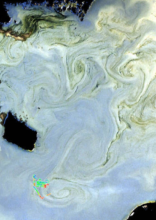The UN deliverd its first-ever global assessment report after seven years’ work by 109 experts in 35 countries – including VLIZ support – creating a baseline to detect and gauge the changing distribution, frequency, and intensity of harmful, often poisonous algal blooms.The consortium of researchers started working with data from almost ten thousand known harmful algal blooms (HABs) occuring worldwide in the period between 1985 and 2018. In some regions the number and intensity of the HABs increased (like in the Mediterranean Sea), while in other regions these phenomena stabilized (like along the European coasts) or decreased. The widely-stated view that HABs are on the rise throughout the world, perhaps due to climate change, isn't confirmed by this study. The authors note that some troublesome algal species may thrive, others decline, as ocean waters warm and acidify.
Where the harmful algae flourish, the authors observe them to have a greater impact on human health and cause more economic damage over time. For example, more food poisonings occur after eating seafood from infected areas, resulting in severe stomach and intestinal complaints or neurological deficits. The algal blooms cause strong water discoloration or foaming that harms coastal tourism. And outbreaks of certain algae species are leading to massive finfish mortalities in aquaculture facilities in the affected area.

VIDEO: The origin and impact of harmful algal blooms explained in this animation
film by the ALFF-project (ALgal Microbiome: Friends and Foes)
An ever-growing world population, especially in coastal areas, in itself leads to more aquaculture activities and exploitation of marine resources, and therefore to an increased risk of damage. But the overexploitation of the coastal seas and ocean also appears to amplify the harmful effects of the HABs in itself.
The present publication, together with the previously published special issue of Harmful Algae, now forms the world's first baseline for further monitoring shifts in the distribution, frequency and effects of harmful algal blooms. VLIZ (Maarten De Rijcke) supplied the Belgian data in collaboration with VMM and FAVV. Read the extensive press release and summary for policymakers on the IOC-UNESCO website. In addition, UNESCO is also launching a new interactive portal for HABs where concerned citizens and scientists can view data and knowledge on harmful algal blooms, from local to global scale.
This global research on harmful algal blooms is sponsored by the Department of Economy, Science and Innovation of the Flemish government and the Intergovernmental Oceanographic Commission (IOC) of UNESCO. The researchers and authors used the HAB species list of the World Register of Marine Species (part of the LifeWatch taxonomic backbone). This, and two other datasets (HAEDAT and HABMAP-OBIS) used in this study, will continue to help clarify scientific questions and policy issues on harmful algal blooms, and their impact on the coastal ecosystem and humans.
(c) Image: European Space Agency - ESA


